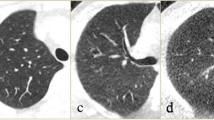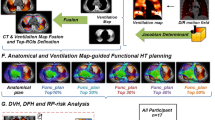Abstract
Purpose
Radiotherapy planning incorporating functional lung images has the potential to reduce pulmonary toxicity. Free-breathing 4DCT-derived ventilation image (CTVI) may help quantify lung function. This study introduces a novel deep-learning model directly translating planning CT images into CTVI. We investigated the accuracy of generated images and the impact on functional avoidance planning.
Materials and methods
Paired planning CT and 4DCT scans from 48 patients with NSCLC were randomized to training (n = 41) and testing (n = 7) data sets. The ventilation maps were generated from 4DCT using a Jacobian-based algorithm to provide ground truth labels (CTVI4DCT). A 3D U-Net-based model was trained to map CT to synthetic CTVI (CTVISyn) and validated using fivefold cross-validation. The highest-performing model was applied to the testing set. Spearman's correlation (rs) and Dice similarity coefficient (DSC) determined voxel-wise and functional-wise concordance between CTVI4DCT and CTVISyn. Three plans were designed per patient in the testing set: one clinical plan without CTVI and two functional avoidance plans combined with CTVI4DCT or CTVISyn, aimed at sparing high-functional lungs defined as the top 50% of the percentile ventilation ranges. Dose–volume (DVH) parameters regarding the planning target volume (PTV) and organs at risk (OARs) were recorded. Radiation pneumonitis (RP) risk was estimated using a dose–function (DFH)-based normal tissue complication probability (NTCP) model.
Results
CTVISyn showed a mean rs value of 0.65 ± 0.04 compared to CTVI4DCT. Mean DSC values over the top 50% and 60% of ventilation ranges were 0.41 ± 0.07 and 0.52 ± 0.10, respectively. In the test set (n = 7), all patients’ RP-risk benefited from CTVI4DCT-guided plans (Riskmean_4DCT_vs_Clinical: 29.24% vs. 49.12%, P = 0.016), and six patients benefited from CTVISyn-guided plans (Riskmean_Syn_vs_Clinical: 31.13% vs. 49.12%, P = 0.022). There were no significant differences in DVH and DFH metrics between CTVISyn and CTVI4DCT-guided plan (P > 0.05).
Conclusion
Using deep-learning techniques, CTVISyn generated from planning CT exhibited a moderate-to-high correlation with CTVI4DCT. The CTVISyn-guided plans were comparable to the CTVI4DCT-guided plans, effectively reducing pulmonary toxicity in patients while maintaining acceptable plan quality. Further prospective trials are needed to validate these findings.






Similar content being viewed by others
References
Puttanawarut C, Sirirutbunkajorn N, Khachonkham S, Pattaranutaporn P, Wongsawat Y. Biological dosiomic features for the prediction of radiation pneumonitis in esophageal cancer patients. Radiat Oncol. 2021;16:1–9.
Rankine LJ, Wang Z, Kelsey CR, Bier E, Driehuys B, Marks LB, et al. Hyperpolarized 129Xe magnetic resonance imaging for functional avoidance treatment planning in thoracic radiation therapy: a comparison of ventilation-and gas exchange-guided treatment plans. Int J Rad Oncol Biol Phys. 2021;111(4):1044–57.
O’Reilly S, Jain V, Huang Q, Cheng C, Teo B-KK, Yin L, et al. Dose to highly functional ventilation zones improves prediction of radiation pneumonitis for proton and photon lung cancer radiation therapy. Int J Rad Oncol Biol Phys. 2020;107(1):79–87.
Faught AM, Miyasaka Y, Kadoya N, Castillo R, Castillo E, Vinogradskiy Y, et al. Evaluating the toxicity reduction with computed tomographic ventilation functional avoidance radiation therapy. Int J Rad Oncol Biol Phys. 2017;99(2):325–33.
Vinogradskiy Y, Rusthoven CG, Schubert L, Jones B, Faught A, Castillo R, et al. Interim analysis of a two-institution, prospective clinical trial of 4DCT-ventilation-based functional avoidance radiation therapy. Int J Rad Oncol Biol Phys. 2018;102(4):1357–65.
Dougherty JM, Castillo E, Castillo R, Faught AM, Pepin M, Park SS, et al. Functional avoidance-based intensity modulated proton therapy with 4DCT derived ventilation imaging for lung cancer. J Appl Clin Med Phys. 2021;22(7):276–85.
Vinogradskiy Y, Castillo R, Castillo E, Schubert L, Jones BL, Faught A, et al. Results of a multi-institutional phase 2 clinical trial for 4DCT-ventilation functional avoidance thoracic radiation therapy. Int J Rad Oncol Biol Phys. 2022;112(4):986–95.
De Bari B, Deantonio L, Bourhis J, Prior JO, Ozsahin M. Should we include SPECT lung perfusion in radiotherapy treatment plans of thoracic targets? Evidences from the literature. Crit Rev Oncol Hematol. 2016;102:111–7.
Hodge C, Tomé WA, Fain S, Bentzen S, Mehta M. On the use of hyperpolarized helium MRI for conformal avoidance lung radiotherapy. Med Dosim. 2010;35(4):297–303.
Han G, Yang L, Deng H, Li H, Yu D, Ma G, et al. Hyperpolarized 129xe gas MRI pulmonary ventilation imaging-based functional avoidance for lung cancer radiotherapy. Int J Radiat Oncol Biol Phys. 2019;105(1):S199–200.
Mathew L, VanDyk J, Etemad-Rezai R, Rodrigues G, Parraga G. Hyperpolarized 3He pulmonary functional magnetic resonance imaging prior to radiation therapy. Med Phys. 2012;39:4284–90.
Frey KA, Gross MD, Hayman JA, Arenberg D, Cai X-W, Ramnath N, et al. Changes in global function and regional ventilation and perfusion on SPECT during the course of radiotherapy in patients with non-small-cell lung cancer. Int J Rad Oncol Biol Phys. 2012;82(4):e631–8.
Eslick EM, Kipritidis J, Gradinscak D, Stevens MJ, Bailey DL, Harris B, et al. CT ventilation imaging derived from breath hold CT exhibits good regional accuracy with Galligas PET. Radiother Oncol. 2018;127(2):267–73.
Tahir BA, Marshall H, Hughes PJ, Brightling CE, Collier G, Ireland RH, et al. Comparison of CT ventilation imaging and hyperpolarised gas MRI: effects of breathing manoeuvre. Phys Med Biol. 2019;64(5): 055013.
Wang R, Zhang S, Yu H, Lin S, Zhang G, Tang R, et al. Optimal beam arrangement for pulmonary ventilation image-guided intensity-modulated radiotherapy for lung cancer. Radiat Oncol. 2014;9(1):184.
Kadoya N, Cho SY, Kanai T, Onozato Y, Ito K, Dobashi S, et al. Dosimetric impact of 4-dimensional computed tomography ventilation imaging-based functional treatment planning for stereotactic body radiation therapy with 3-dimensional conformal radiation therapy. Pract Radiat Oncol. 2015;5(5):e505–12.
Li S, Liu J, Gao S, Yin Y, Zhang L, Han Y, et al. CT ventilation image-guided helical Tomotherapy at sparing functional lungs for locally advanced lung cancer: analysis of dose-function metrics and the impact on pulmonary toxicity. Radiat Oncol. 2023;18(1):6.
Mori S, Ko S, Ishii T, Nishizawa K. Effective doses in four-dimensional computed tomography for lung radiotherapy planning. Med Dosim. 2009;34(1):87–90.
Westcott A, Capaldi DP, McCormack DG, Ward AD, Fenster A, Parraga G. Chronic obstructive pulmonary disease: thoracic CT texture analysis and machine learning to predict pulmonary ventilation. Radiology. 2019;293(3):676–84.
Ren G, Zhang J, Li T, Xiao H, Cheung LY, Ho WY, et al. Deep learning-based computed tomography perfusion mapping (DL-CTPM) for pulmonary CT-to-perfusion translation. Int J Rad Oncol Biol Phys. 2021;110(5):1508–18.
Capaldi DP, Guo F, Xing L, Parraga G. Pulmonary ventilation maps generated with free-breathing proton MRI and a deep convolutional neural network. Radiology. 2021;298(2):427–38.
Kipritidis J, Woodruff HC, Eslick EM, Hegi-Johnson F, Keall PJ, editors. New pathways for end-to-end validation of CT ventilation imaging (CTVI) using deformable image registration. 2016 IEEE 13th international symposium on biomedical imaging (ISBI); 2016: IEEE.
Ronneberger O, Fischer P, Brox T, editors. U-net: Convolutional networks for biomedical image segmentation. Medical Image Computing and Computer-Assisted Intervention–MICCAI 2015: 18th International Conference, Munich, Germany, October 5–9, 2015, Proceedings, Part III 18; 2015: Springer.
Woo S, Park J, Lee J-Y, Kweon IS, editors. Cbam: Convolutional block attention module. Proceedings of the European conference on computer vision (ECCV); 2018.
Isensee F, Jäger PF, Kohl SA, Petersen J, Maier-Hein KH. Automated design of deep learning methods for biomedical image segmentation. arXiv preprint arXiv:190408128. 2019.
He K, Zhang X, Ren S, Sun J, editors. Deep residual learning for image recognition. Proceedings of the IEEE conference on computer vision and pattern recognition; 2016.
Zhou Z, Siddiquee MMR, Tajbakhsh N, Liang J. Unet++: Redesigning skip connections to exploit multiscale features in image segmentation. IEEE Trans Med Imaging. 2019;39(6):1856–67.
San José Estépar R. Artificial intelligence in functional imaging of the lung. Br J Radiol. 2022. https://doi.org/10.1259/bjr.20210527.
Fain SB. Machine learning reveals the texture of regional lung ventilation at CT. Radiological Society of North America; 2019. p. 685–6.
Kida S, Bal M, Kabus S, Negahdar M, Shan X, Loo BW Jr, et al. CT ventilation functional image-based IMRT treatment plans are comparable to SPECT ventilation functional image-based plans. Radiother Oncol. 2016;118(3):521–7.
Matuszak MM, Kashani R, Green M, Lee C, Cao Y, Owen D, et al., editors. Functional adaptation in radiation therapy. Semin Radiat Oncol; 2019: Elsevier.
Acknowledgements
Not applicable.
Funding
This study was supported by the National Natural Science Foundation of China (No. 82202300) and a grant from Jiangsu Provincial Double-Innovation Doctor Program.
Author information
Authors and Affiliations
Contributions
Original idea and study design (SSL, ZH, JZ, YYK, JBG); Data collection and analysis (SBG, YCY, LZ, YCH, JL, ZH, JXW); Manuscript writing (ZH, SSL, JZ); Important contributions to radiotherapy plan design (SSL, ZH). All authors read and approved the final manuscript.
Corresponding authors
Ethics declarations
Conflict of interest
The authors declare that they have no competing interests.
Ethical approval and consent to participate
The ethics committee approved this retrospective research at Nanjing Drum Tower Hospital, and informed consent was waived. The CT data were anonymized for the scientific purpose of this work. This retrospective study was performed in line with the principles of the Declaration of Helsinki.
Consent for publication
Not applicable.
Additional information
Publisher's Note
Springer Nature remains neutral with regard to jurisdictional claims in published maps and institutional affiliations.
Supplementary Information
Below is the link to the electronic supplementary material.
About this article
Cite this article
Hou, Z., Kong, Y., Wu, J. et al. A deep learning model for translating CT to ventilation imaging: analysis of accuracy and impact on functional avoidance radiotherapy planning. Jpn J Radiol (2024). https://doi.org/10.1007/s11604-024-01550-2
Received:
Accepted:
Published:
DOI: https://doi.org/10.1007/s11604-024-01550-2




